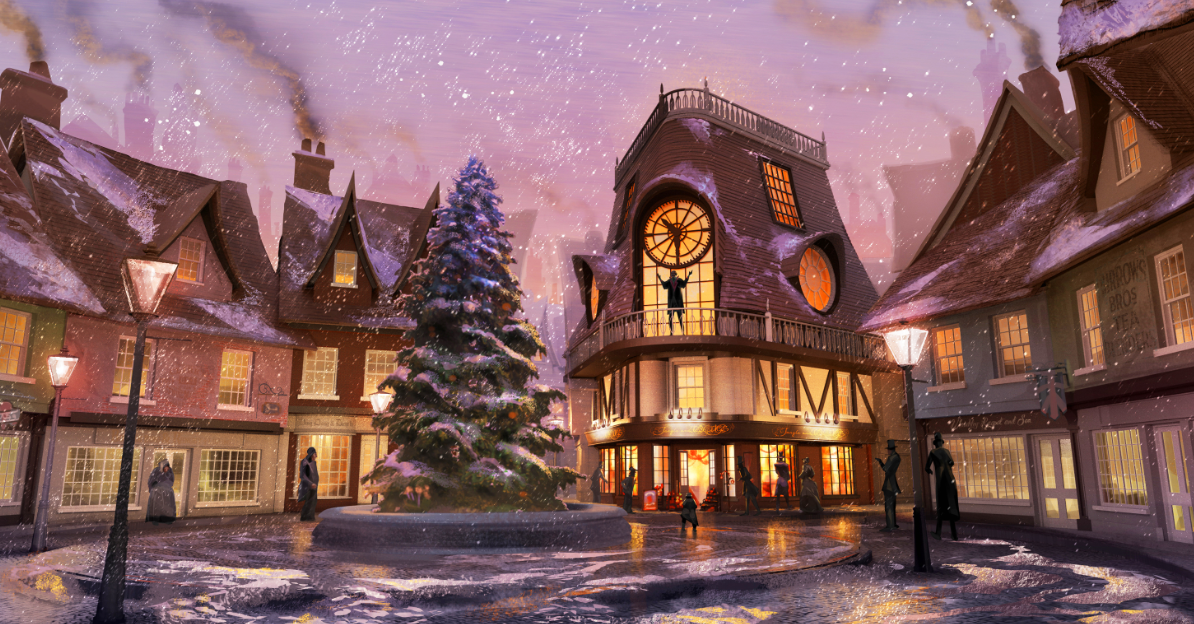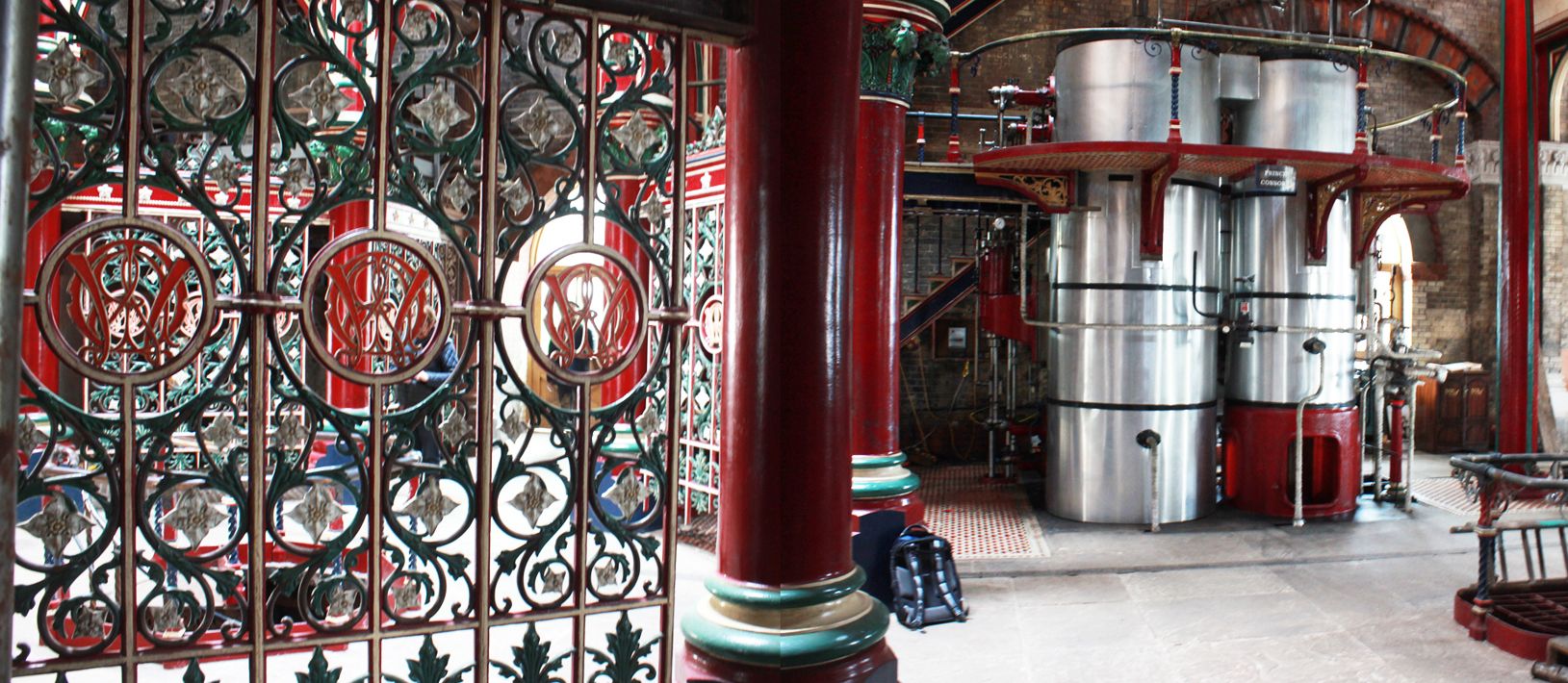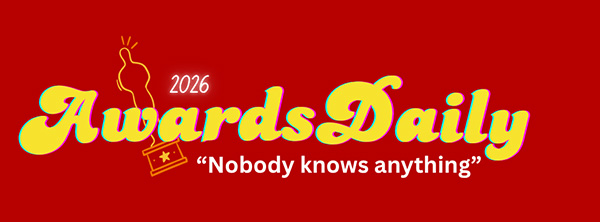Netflix’s Jingle Jangle: A Christmas Journey feels both familiar but utterly modern—even though it’s a period piece. Director David E. Talbert has been working on this film for nearly two decades, and you can tell that his designers put a lot of care into their designs and execution. Production designer Gavin Bocquet has designed for Star Wars and the Young Indiana Jones franchises, but Jingle Jangle is so magical and warm that you will feel like you stepped into your favorite Christmas story.
There are two toy shops at the center of Talbert’s film. Jeronicus Jangle creates a world fueled by imagination and invention, and his shop is inviting. It’s a feast for the eyes, and you want to check out every toy to make sure you get the best one. When Jeronicus’s ideas are stolen, Gustafson builds an empire on greed and quick schemes that leads to a hollow experience. He sells the kind of toys that break after five minutes and you never play with again.
Bocquet was deeply inspired by Victorian architecture and colors to shade his designs, and the result is timeless and classic. Even though a city is never specified, it even feels like Talbert and Bocquet have created a new history that will inspire children for generations to come.
Awards Daily: What conversations did you have with David E. Talbert about establishing this world?
Gavin Bocquet: My first meeting was a Skype interview. With David, it’s almost impossible to not get an immediate enthusiasm with him. It’s taken him over 14 years to get to this stage and going through his theater background, it was supposed to be a staged production. Luckily, Netflix wanted to make it a feature, and they told him and his wife, Lyn Sisson-Talbert, to write to the story and not to the budget. They felt quite open, and it’s our job to make it work. No studio has given a film too much money.
AD: That’s not a problem you hear very often.
DB: Not ever. You always want everything that you have to look 10 times much bigger than the budgets you have. David’s first instincts, which really surprised me, were the original Willy Wonka and the Chocolate Factory and Chitty Chitty Bang Bang and that was the spirit of what he wanted to do. That classic Victorian English fairy tale story and set it in a mythical place that felt very grounded with a little bit of something fantastical about it. He wanted you to think these characters were in a real place while the costumes from Michael [Wilkinson] and the hair from Sharon [Martin] were going to be a little bit extraordinary and then a little bit fantastical.
 AD: Definitely.
AD: Definitely.
GB: And we had to create a clever balance between not dominating the frame in what they were doing, color and texture-wise, but also giving interesting backgrounds for them to work in, especially as you say, with the shop and the props and how that all works. An interesting little story. We knew David was a Chitty Chitty Bang Bang fan. So through a contact of ours, we knew somebody who had one of the six Chitty Chitty Bang Bangs that still exists. So one day we went through Lyn, and we brought David out to show him something on the outside of the Stage. We’d actually brought the Chitty Chitty Bang Bang.
AD: He must have lost it.
GB: He did. He gets very emotional at times and they let him drive it with his son around the quad, but he broke the handbrake. (Laughs) Anyway, it was our job over the next few months, to give David the Backgrounds and the Look that he had in his head for 14 years.
AD: Wow. I didn’t realize he was developing it for that long.
GB: And I’m not even sure whether it was a musical originally. It might have just been a play. We tried to design the sets, especially the town square and the shop, which were going to be stage sets in theatrical way. You could almost imagine the proscenium arch theater. David was going to try to film a lot of the dance routines from that position, so you can feel that when you’re in the main town square and in the shop, you do get a chance to sort of see that environment as you might see it in the theater.
AD: When I was watching it the second time, I did wonder, when we are going to see it as a stage musical? David really lends the space to that.
GB: It’s nice that that translated.
AD: The town square reminded me of something from a Charles Dickens novel or even Diagon Alley from Harry Potter.
GB: The balance was to go not too far and make it look real. We knew we could build part of the street scenes for the dance sequences. We could design the layout of the street but we couldn’t design the architecture or the actual textures until we found a location. I worked in Norwich on Jack the Giant Slayer in the cathedral and I knew there was this one street that hadn’t really changed. It hasn’t become a fashion place with Gucci stores—it was still quite old-fashioned. Some of those villages up in Norfolk or Norwich also have color in the architecture. Most Victorian architecture is wood or plaster, stone or brick, but Norwich had these soft, tertiary colors that served as a spark that we could get color into the buildings. However subtle it was. We weren’t allowed to change the colors on the Location street itself, since it is protected but we used all those references for how the buildings look in the town square.
AD: We have to talk about Jeronicus’s shop since the film opens with that. There’s that awesome checkerboard floor and all the dark wood accents. Even the shelves are packed with toys. Where do you start with such a magical set like that, since it transports us so much?
GB: There are two versions of it since we see it as a pawnbroker shop as well. For the size of budget we had, it was quite a challenge especially for the propmakers to fill it with working props. On the prop side, we had a lot of props and toys that physically went up and down, made throughJim McKeown, our HOD propmaker, that weren’t very technical but looked great. We just wanted movement. My first thought was that the shop was a theater stage and you wanted things to go up and around. I had never done a musical before, so I didn’t know the space needed for choreography. With the spiral staircases and the elevator, we were trying to give as many options of movement in that space so you could shoot at any angle. One of our concept artists, Gert [Stevens], is also very much into virtual 3D, so it’s the first time that some of our work is in a virtual world. We could basically give our design models to Gert, and David could use it to walk into the set with his VR Glasses. There was a moment when we took David into the virtual shop, and it wasn’t fully dressed yet, but Buddy was flying around. He put the glasses on and it all went very quiet. He took the glasses off and left the room.
 AD: Oh no…
AD: Oh no…
GB: He came back in and said that after 14 years of trying to get this done, he suddenly felt like he was there and he felt like he could touch Buddy. David hadn’t really done a lot of big set building on his features and the VR side of it was an interesting way to give you an idea of what you can do, especially with choreography. Two feet more or less in either direction can make quite a big the difference to whether a Set works or not so it’s important to get it right.
AD: I had thought of how the space was formatted because you have to take into consideration where the camera is in addition to where the dancers are. In the song that Ms. Johnston sings, you can see how the spacing is really important.
GB: It’s just like stunt work. Everything needs to be laid out and choreographed. We actually did build a scaffold version of it so our choreographer, Ashley Wallen, could work with the scale and space on another stage. David has the most amazing enthusiasm, and everyone agrees that he brings you into his world. He makes you just as excited and it feels like your own personal project. As you get older, you know you have a lot of experience and you know how to do your job, but that knowledge can suppress you a little bit, do you know what I mean?
AD: Yeah, I do. When you’re young, you can do anything and you aren’t inhibited.
GB: When you’re young, your naivete is incredibly creative. When you get older, you can get more nervous. With David, he brought us all back to that childhood phase with his enthusiasm. It was lovely. His sincerity and his passion really come across.
AD: One of the other major sets is Gustafson’s toy shop. Is it green as a nod to The Wizard of Oz? And money? Some of the spaces are open and empty and I thought that maybe you decided to do that since Gustafson, like The Wizard, is a sham? Or am I overthinking it?
GB: I think all those things are part of it. He’s up on the hill. Green is a very strong Victorian color, especially in the factory world. Talking with Michael in costumes, he could make strong choices with his fabrics and there are greens in factory tiles of that time. The industrial Factories of that time were often using brick red, cream, and green. The factory location where we shot was an old sewage works on the east end of London.
AD: Oh, ok.
GB: They are repairing it in a sense so it’s half done and half not done. We keyed all the colors for the factory in there. We had to add a lot of things to it but the basic premise of that was very cast iron elegant, Victorian industrial engineering. When we took David down there, he was amazed. We only see glimpses of it, but we never sought out to create the entire factory. We added a lot of G’s and pipework. Interestingly, the columns from the Victorian times, they had dressed figs hanging on them because figs were very good for diarrhea.
AD: (Laughs)
GB: The designers had a good time designing figs since it was a sewage works. (Laughs)
AD: And Keegan-Michael Key’s character is full of shit…
GB: Yes. (Laughs) We tried to go as far as we could with color at the time because the pawnbroker shop, at that time, is very monochromatic and dark. The fact that you could jump from one to the other was brilliant. It’s hard on that sort of film to get one color philosophy because the props and costumes are multicolored. We had to make sure it wasn’t a messy jigsaw puzzle. We are proud of the color wave of the factory. Green was very popular during these Victorian times and it’s actually why a lot of people died. There was a lot of green wallpaper and they used arsenic to dye it.
AD: Really? I had no idea!
GB: That’s why, in the UK, an awful lot of spa towns sprang up around the coast so people could go to get better, not realizing why they were ill. We have COVID, and they had arsenic walls.
AD: I love all the stained glass everywhere. Jeronicus’s shop has this incredible skylight, and we get two perspectives of it, depending on whether we are upstairs in the workshop or not. Gustafson’s shop doors swivel around.
GB: David always wanted a theatrical entrance. A door is a door, isn’t it? Whenever we could, he wanted us to do an interesting door. The doors to the shop actually took a long time because of how they spun around. He just wanted to make sure that you felt Jeronicus’s was doing everything around the place to make it interesting. They look quite simple but you can imagine with the stain glass how detailed they are. Philippa Broadhurst did all that and the bookwork as well. Gustafson’s shop has the same detail because you have to remember that he came from that world. There is a big eye-shaped window in Gustafson’s office that looks over the town.
AD: I’m glad you brought up that point about Gustafson, because he cheated his way to have his success. Of course, he would build his empire in a way to replicate how an honest man would. Jeronicus’s shop influencing Gustafson’s shop is very character-driven.
GB: To a huge scale.
AD: One is very warm and one is a machine.
GB: Don Juan’s desk is a mirror of his desk so there was a mini version of that. What was great was that everybody got really enthused doing these things. How does a 12-inch person do all that? David gave us so much freedom to express ourselves to help achieve his vision.
Jingle Jangle: A Christmas Journey is available to stream on Netflix.





















